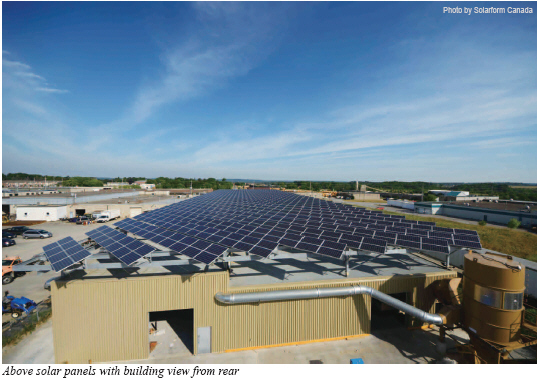By Barbara Graham
.jpg)
 The project began with a targeted production capacity of 250 kW on a site that was less than 35,000 square feet. The building was older and had been constructed in phases resulting in 3 different roof heights, numerous roof penetrations from previous and existing tenants and was very long and narrow with an azimuth of 135 degrees. The project began with a targeted production capacity of 250 kW on a site that was less than 35,000 square feet. The building was older and had been constructed in phases resulting in 3 different roof heights, numerous roof penetrations from previous and existing tenants and was very long and narrow with an azimuth of 135 degrees.
The owner quickly realized that the production target could never be met with a traditional ballasted solar rack system due to shading and production losses related to area challenges and roof hardware.
A raised solar rack system was proposed by the design team to equalize the roof heights. At the owners request, three leading roofing companies were consulted to determine the minimum acceptable height for the raised racking to allow normal roof maintenance and service of roof-ware. A height of 5 feet was determined to be acceptable by the roofing experts and this height was chosen as the minimum height above the highest roof section of the building. Due to the inconsistencies of the building roof heights, this decision resulted in an average of 9 foot roof/rack clearance for the balance of the solar building area.
Having determined the proper solar rack clearances, the owner contracted Rob Thorne of Canadian Renovations & Restorations Inc. with a clear mandate to engineer and design the best valued rack system for a 250 kW AC solar installation at this site.
Additional design constraints were quickly determined and factored into the project design. Largely based on the choice of top quality Juli New Energy solar modules, which are all plus rated and had an average efficiency of over 15.3% (now available at over 15.9%), coupled with the use of highly efficient Power-One 10 kW string inverters, a 17% de-rating on the target system size was accepted for modeling, DC influenced calculations, and the selection of panel angle.
The building azimuth constrained the rack system in two manners: it had to allow for a rugged, high weight capacity superstructure, and the solar module rack system had to be independent of this superstructure and capable of azimuthal based adjustments relative to the building.
In the end, a raised, hot-dipped, zinc coated, I-beam superstructure was selected as the design with a triangular truss module rack. Over 1,623 modules were accommodated in the design at a panel angle of 19 degrees. The 21 string inverters were selected for high efficiency, maximum numbers of independent MPPT’s and string allowances, NEMA 4 ratings for extreme weather conditions and were mounted to the superstructure in an easy-to-service, readily accessible manner.
.jpg)
Due to the age of the building and the lack of detailed structural drawings, the design and engineering teams excavated footings in three locations within the building to assess soil and footing strength and implemented necessary building remedies to support the weight and wind loading of the intended elevated rooftop structure.
Additional engineering of the site included the insertion of 23 roof column penetrations and 41 wall column extensions. Twenty four inch steel stubs were welded and attached at these penetrations and extensions upon which the raised superstructure was mounted.
To accommodate the target 250 kW (AC) - 308.5 kW (DC), it was determined by the design team that the solar array would need to be cantilevered over the building envelope on three sides due to spatial constraints. The raised system was engineered, constructed and designed for the maximum wind and snow-load conditions in the area. The solar modules were placed at 19º tilt, two-up, in landscape mode, with racking at intervals to accommodate inter-panel racking shading conducive to the latitude of the building. The modules were wired to string inverters and the AC/DC electrical was designed to stay within a maximum target of 1.5% voltage loss. The Juli New Energy solar modules were grounded to the racking and the racks grounded to the building steel and building ground through methods approved and inspected by the Ontario Electrical Safety Authority.
.jpg)
Rob Thorne, lead designer says, “At first, we constructed the raised roof solar generator completely out of necessity, but in the end, we discovered, after experience and financial analysis, that ‘building up’ yields a higher performing and more cost effective 20-year system than placing the modules and racking on the roof deck. Since August, we have completed a second 250 kW raised roof solar system and expect to complete 3 others by spring 2012.”
Non-building related challenges included the presence of a large dust collector and cellular communication tower in the immediate vicinity of the building causing solar shading to the proposed array of modules. The collector was ultimately lowered and exchanged while the cell tower effects were minimized with newer, smaller profile communication hardware.
Finally, in the presence of the Local Distribution Company and ESA, the system was connected and commissioned. Subsequent power analysis, safety testing and functionality analysis lead to the declaration of commercial operation on July 21, 2011. The resulting performance tests yielded a voltage loss of 1.17% from inverters to meter, well within the 1.5% engineering target.
System owner, Bill Melnik states, “This solar system was designed with excellence in mind. There was little compromise to system quality and revenue yield. In the end, this design may well prove to be the best solution for solar rooftop installations in North America. The system allows maximum use of rooftop space, minimizes heat effects of flat roof solar installations, minimizes snow effects and provides a better revenue yield per square foot of rooftop than ballasted systems. It further retains any additional roof space for future use as a building or energy resource. We would be happy to discuss and support our conclusion with anyone who wishes to pursue this design.”
.jpg)
On August 31, 2011, a Ribbon Cutting Ceremony was held, on the roof-under the shade of the solar modules. Over 130 people toasted this achievement to the sound of a live jazz band with catered food and refreshments.
Major benefits of a Raised Roof Solar System:
-No requirement to budget for pre-system roof repair or replacement
-Maximum number of watts per square foot of roof space─current designs exceed 10 watts per square foot
-Robust, maintenance-free structures that are designed for wind uplift and compressive forces
-No solar modeling requirements for roof obstructions and shading such as air conditioning units or vent stacks
-Excellent northern climate and snow performance
-Easy to wire for DC and AC including inverter access and service
-Minor impact to the fixed costs of the system─excellent payback when roof maintenance costs or scheduled roof replacement costs are factored into the financial model
-Exceptionally flexible with different building azimuthals
-Superb system access for complete serviceability post-installation
-Completely recyclable.

Barbara Graham is Educator, Teacher and Writer. Upon retirement from a 30-year successful career as an educator, Barbara has furthered her passion for the greening the globe by focusing attention on Alternative Energy and the Green movement.
For more information, please send your e-mails to pved@infothe.com.
ⓒ2011 www.interpv.net All rights reserved.
|



